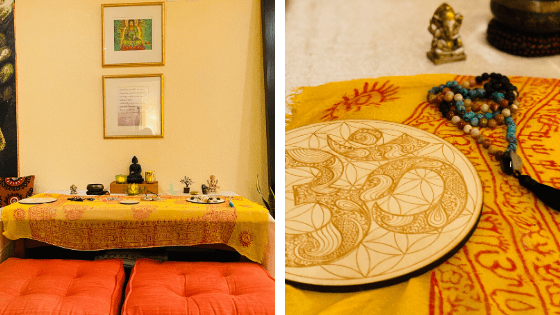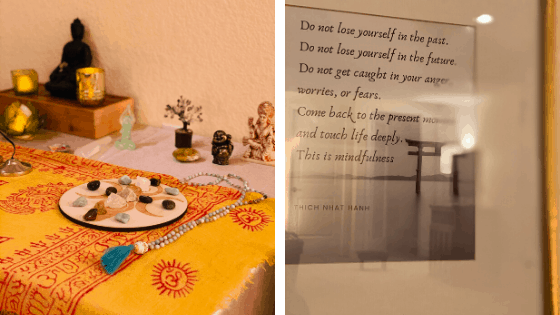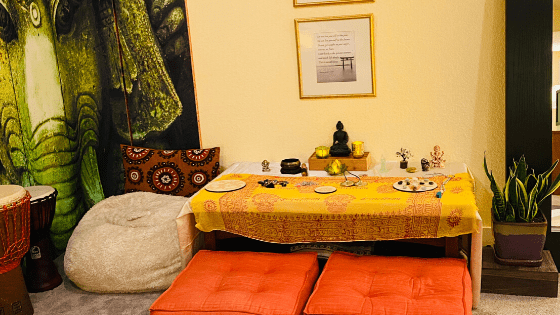By Michele Forsberg PT, MS
As last year was coming to a close, my family and I expressed a shared desire to make meditation a regular practice. I had created a small altar in our office, but it didn’t compel us to sit there. We were on a mission to create a space that felt sacred to all, that was inspiring, comfortable, and open. It feels even more vital to have this peaceful place now that we are social distancing. Having this space keeps me grounded for my morning meditation and gives me reassurance that everything will be okay.
Location of Choice We started this quest with divine intervention from Marie Kondo, and agreed that the treadmill in our basement living room had to go (no joy) and that we would build our altar there instead.
We needed a little guidance on how to set up a space that would work for us all. Here’s what I’ve learned from the many articles and Pinterest boards I’ve studied.
Number One, find a space where you will feel comfortable and compelled to spend quiet time. Get creative, it can be just a corner of your room, a table, a shelf, a place most importantly that you feel good about. For me that meant, visually it had to draw me in, it had to feel inviting.
Number Two, make it meaningful to you. Ours was a collaborative effort, this altar was not going to be just for me. We started with one rustic thrift store find; a coffee table covered with a tablecloth and a Tibetan prayer cloth tapestry.
Compassion and Focus: Our theme for our artwork hanging above the altar displays a lovely image of Quan Yin, the Buddhist goddess of compassion. The other hanging is a quote from Thich Nhat Hanh on staying in the present moment. When your mind wanders during meditation, it’s good to have a calming reminder of what is most important.

A Family of Three
Intention Setting each of us chose a section of the altar to honor what we wish to evoke through meditation.
My husband had the idea to turn our shoji screen to the other side, the Ganesha side. He also chose to place a tiny Ganesha statue on his side of the altar. Ganesha, the elephant headed Hindu god. I learned in one of our mala workshops, that he is the remover of obstacles. This deity represents strength and power, protection. On his side of the table also rests the mala he lovingly made and his om crystal grid.
My daughter’s space, centered on the altar just below our Buddha statue and candles; contains her mala. and a small lotus crystal grid. I do believe the mala workshop inspired her to create this space with us. She found deep gratification and peace in the crafting process and thoroughly enjoyed her mala beads with the mantra that we learned in the class.
My side of the altar; I decided on a theme of abundance, love and feminine wisdom.
Here’s my list:

Lakshmi statue represents wealth and beauty
Tree of Life with crystal leaves- a loving gift from my daughter and husband
Laughing Buddha– because joy and laughter and he’s so dang cute.
Heart-shaped Green Opal – to represent heart opening
Selenite Wand – for cleansing, clarity and protection
Goddess Crystal Grid– with following stones- amazonite, labradorite, rose quartz, selenite, tigers eye, keeping in the theme of abundance.
Mala beads and rose petals that were blessed.
Other items we’ve included: candles for light, tingsha cymbals and a singing bowl for sound.
Essential oil diffuser to diffuse sandalwood or other scents that evoke a sense of calm and spiritual enlightenment.
The Space Evolves It’s not our first altar, but it’s our best so far. We’ve been collecting some of these items for other meditation spaces. My husband and daughter will fill their crystal grids in time when they find what resonates with their intentions. As we grow and practice more, we will add and delete items from our space.
If you have been wanting to create a sacred space for meditation, journaling, and self connection; the best advice I can give you is that there is no right or wrong. Make it your space, add what feels authentic to you and your needs. We certainly had fun creating this space and look forward to spending time there every day. On a side note, I don’t necessarily worship any of these Gods/Goddesses, to me I deeply connect with what they represent and symbolize. If you have religious symbols that you wish to use, do that. You could also use just photos of nature and cherished items you have that give you a sense of peace. This is a time to get creative and decide what you want this space to look and feel like. Tell us what your sacred space holds for you.
If you live in and around Longmont, Colorado, we occasionally host events like Mala Workshops and Meditation Workshops so check out our Events Page or join our Mailing List.


Hi Michele,
Where did you get the goddess crystal grid?
I would love to have one in my home or altar.
Hi Rachel, I got them on Etsy from ZenandMeow